Capricornus is one of the zodiacal constellations, being the smallest among them. It is the 40th largest constellation in the sky, out of the 88 modern constellations.
Key Facts & Summary
- Capricornus is one of the 88 modern constellations, yet it was also one of the first 48 constellations listed by the Greco-Roman astronomer, Ptolemy, in his 2nd century Almagest.
- Capricornus is a relatively faint constellation, with only its brightest star, Deneb Algedi, shinning above magnitude 3.
- Deneb Algedi is a white giant that has an apparent magnitude of 2.81.
- Capricornus holds the 40th position as the largest constellation in the sky, being the smallest zodiacal constellation, stretching for over 414 square degrees.
- Currently, around 5 stars that host planets have been discovered in Capricornus.
- There are also 5 meteor showers associated with the constellation of Capricornus, the Alpha Capricornids, Chi Capricornids, Sigma Capricornids, Tau Capricornids, and the Capricornids-Sagittariids.
- Only one Messier object is present in the constellation of Capricornus, the globular cluster Messier 30.
- The constellation of Capricornus is commonly depicted as sea-goat, a mythical creature that is half goat, half fish. The name Capricornus is Latin for horned goat.
- Capricornus is located in an area of the sky called the Sea or the Water, which consists of many water-related constellations such as Aquarius, Pisces, and Eridanus.
- There are many interesting deep-sky objects present in Capricornus, apart from the aforementioned Messier 30, there are also many more star clusters and galaxies.
- Some of them are the spiral galaxy NGC 6907, or the large galaxy group HCG 87.
- Many mythical creatures are associated with Capricornus, such as the deity Pan, or the goat Amalthea who suckled Zeus when he was young.
The constellation of Capricornus is the second-faintest constellation in the sky after Cancer. Despite its faintness, this constellation is associated with many myths and images that go back into antiquity.
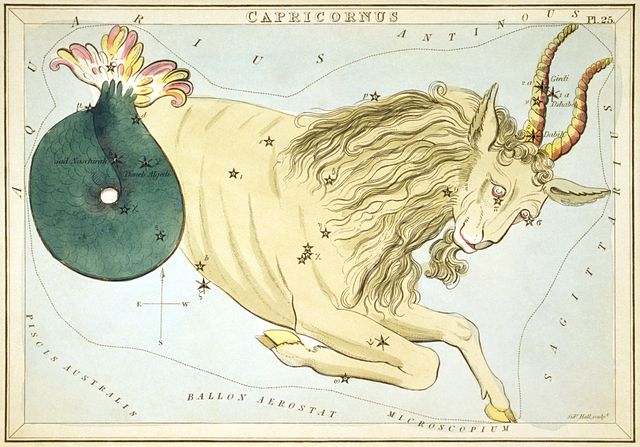
The story of Capricornus can be traced back to the Babylonians and the Sumerians. The Sumerians called it SUHUR-MASH-HA – the goat-fish, while the Babylonian star catalogs that date back to 1000 BC, mention the constellation as MUL.SUHUR.MAS, – also meaning goat-fish.
In the early Bronze Age, the constellation of Capricornus marked the winter solstice, and in modern astrology, Capricorn’s rule still begins on the first day of winter.
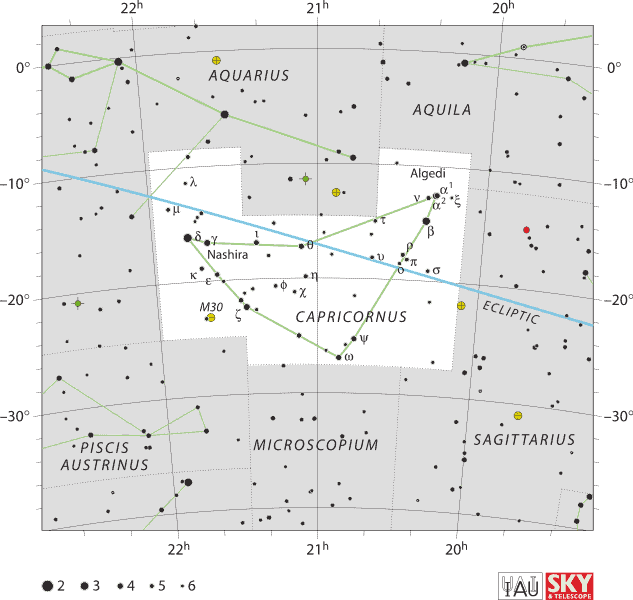
Location
The constellation of Capricornus is the 40th largest constellation in the sky, being the smallest of the 12 zodiacal constellations. Capricornus spreads out for over 414 square degrees.
The Capricornus constellation is located in the fourth quadrant of the southern hemisphere (SQ4) and can be seen at latitudes between +60o and -90o.
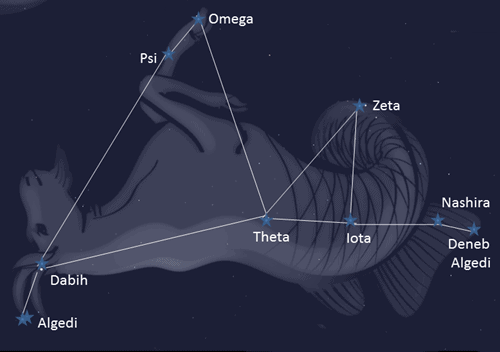
- Right Ascension: 20h 06m 46s to 21h 59m 04s
- Declination: -8.4043999o to -27.6914144o
- Visible: +60o and -90o
- Best viewed: at 21:00 (9 p.m.) during September
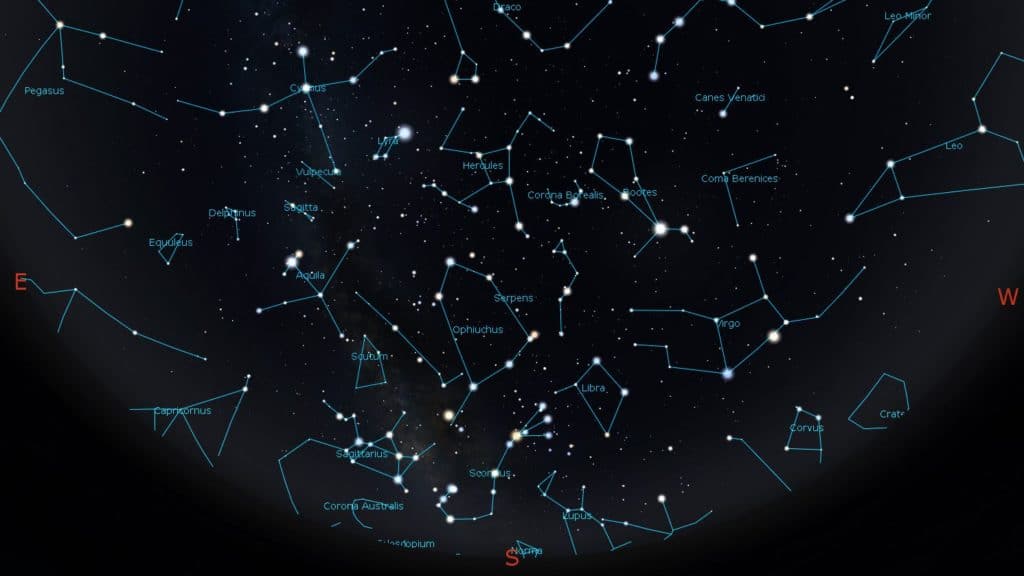
The neighboring constellations around Capricornus are Aquarius, Aquila, Microscopium, Piscis Austrinus, and Sagittarius. Capricornus belongs to the Zodiac family of constellations, along with Aries, Taurus, Gemini, Cancer, Leo, Virgo, Libra, Scorpius, Sagittarius, Aquarius, and Pisces.
Messier Objects
The constellation of Capricornus contains only one Messier object, namely, the globular cluster Messier 30.
Messier 30
Messier 30, also designated as NGC 7099, is a globular cluster of stars first discovered by astronomer Charles Messier in 1764. It can be viewed with a pair of 10×50 binoculars since it has an apparent magnitude of +7.7.
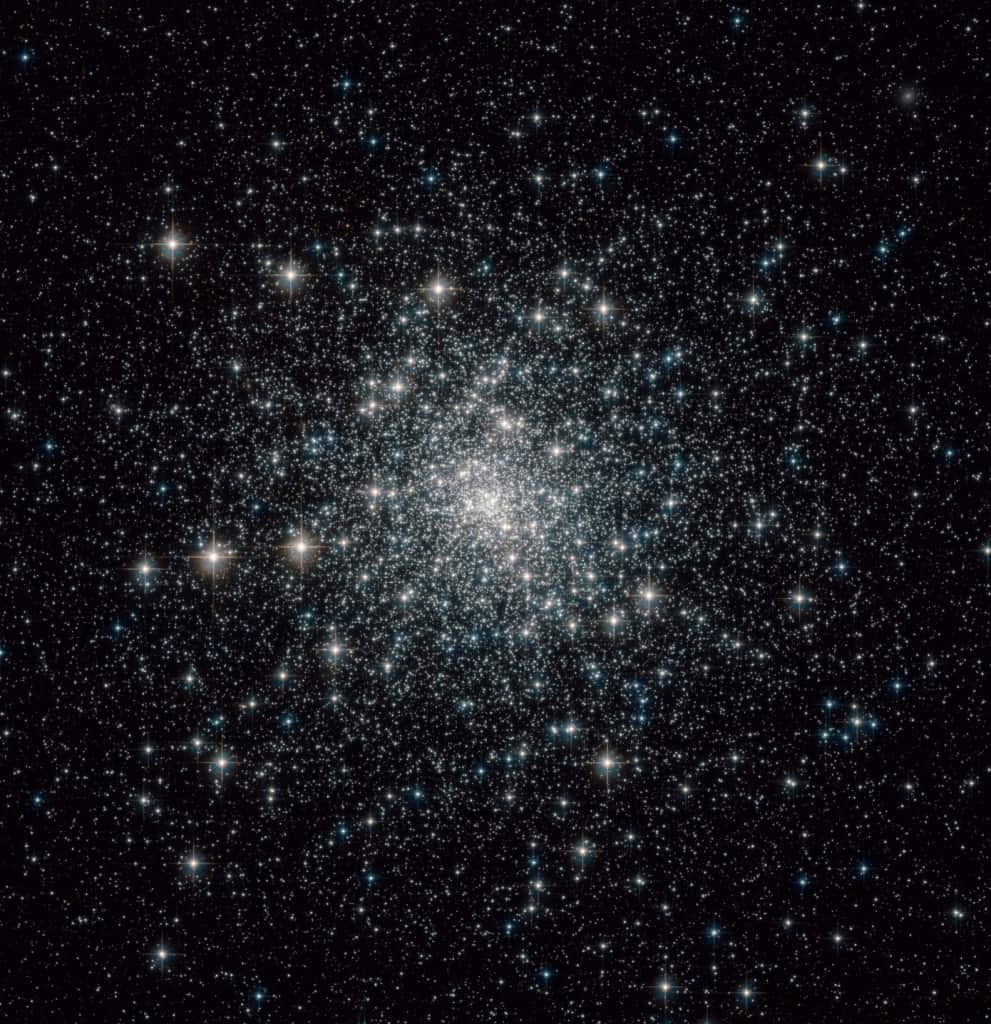
Messier 30 is best viewed during August. It is located at around 27,100 light-years away from Earth. Messier 30 stretches up for around 12 arcminutes / 93 light-years, having a core of around 1 arcminute.
Messier 30 is estimated to be 12.93 billion years old, and it has a total mass of around 160,000 times that of the Sun. Since this globular cluster is following a retrograde orbit through the inner galactic halo, it is speculated that it was acquired from a satellite galaxy of the Milky Way.
Notable Stars
There are few bright stars in the constellation of Capricornus. Only one is above magnitude 3, and that is Deneb Algedi, which has an apparent magnitude of 2.81.
However, there are several interesting stars located in Capricornus. Currently, around 5 stars that host planets have been discovered in Capricornus.
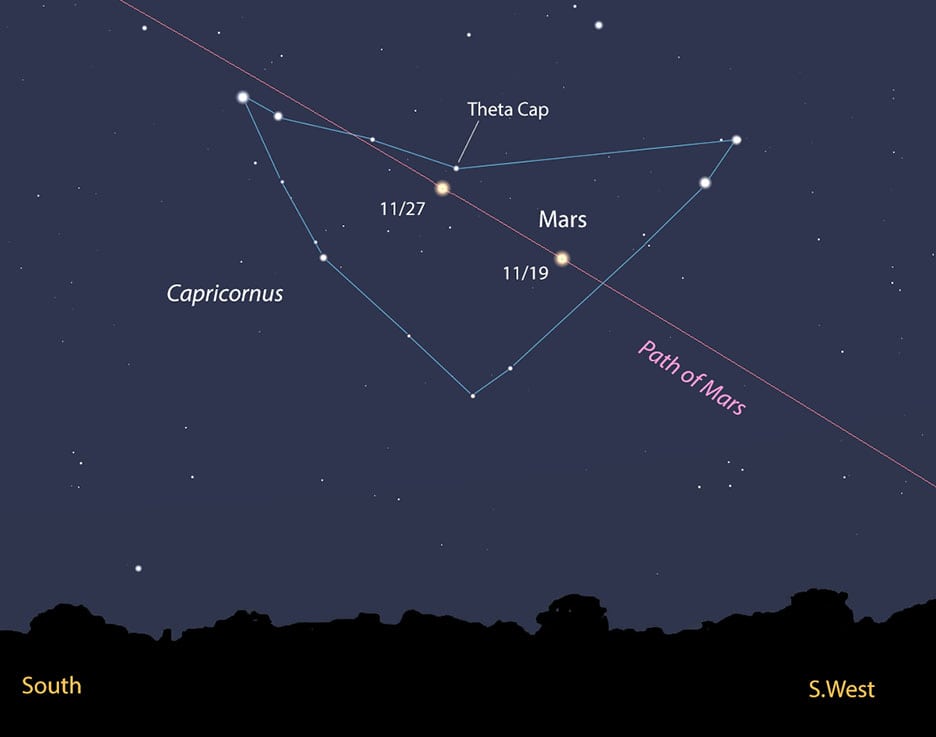
Deneb Algedi
Deneb Algedi, designated as Delta Capricorni, is the brightest star in Capricornus, being 8.5 times brighter than our Sun. Deneb Algedi is a multiple star system with its two prominent stars being Delta Capricorni A, a white giant star, and B, which is a G-type star.
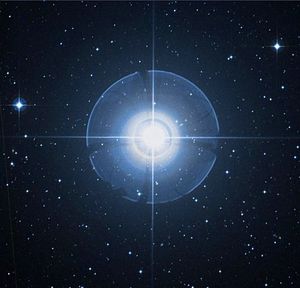
Delta Capricorni A is an Algol-type eclipsing binary star, with the combined visual magnitude of the two stars reaching 2.81, while dropping by 0.24 when the two stars eclipse each other.
The primary star is also classified as a chemically-peculiar Am star. Delta Capricorni A has around 200% of our Sun’s mass, 191% of its radius, being much hotter and spinning faster, having a rotational velocity of 105 km / 65.2 mi per second.
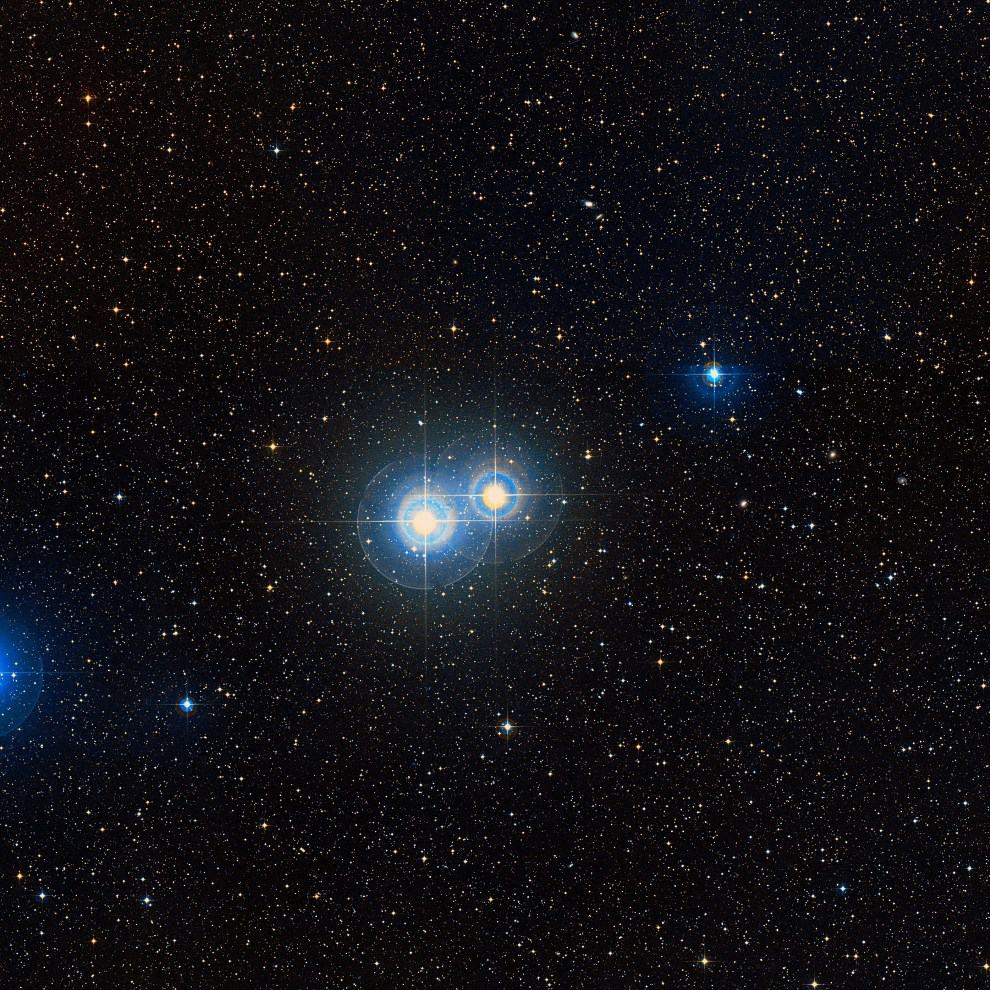
The secondary star is smaller than our Sun, having 73% of its mass, 90% of its radius, and it is also cooler than our Sun, with temperatures around 4,500 K.
Like other stars such as Denebola or Deneb, Deneb Algedi is derived from the Arabic word for “tail” – “Deneb” – since its position in the sky marks the celestial goat’s tail. Deneb Algedi is situated at around 38.70 light-years away.
Dabih
Dabih, designated as Beta Capricorni, is a multiple star system located at around 328 light-years away from us. Dabih is the second-brightest star in Capricornus, having an apparent magnitude of 3.05.
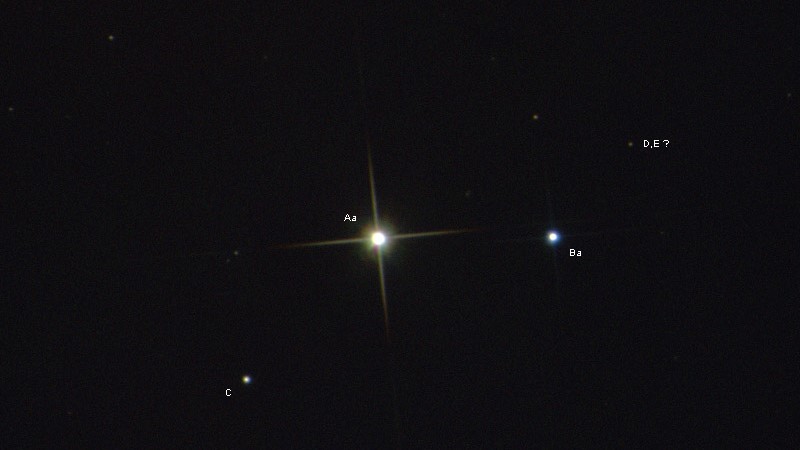
Both the primary star, Dabih Major, and the secondary star Dabih Minor, are composed of multiple stars. Dabih Major has at least three companions, the brightest being an orange K-type giant.
The second brightest component is a bluish-white main-sequence dwarf, which has an apparent magnitude of 7.20. Dabih Minor is comprised out of an A0-class giant of magnitude 6.1, and a mercury-manganese star.
The name Dabih comes from the Arabic “al-dhabih” – meaning “the butcher”.
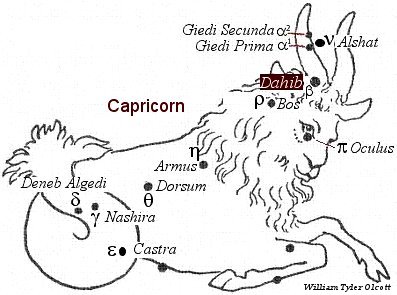
Algiedi
Algiedi, designated as Alpha Capricorni, is an optical double star comprised out of Prima Giedi and Algiedi. The two stars themselves are comprised out of several other stars.
Algiedi is an evolved G-type subgiant star with an apparent magnitude of +3.57. Algiedi has around 205% of our Sun’s mass, 838% of its radius, and it is 40.4 times brighter than our Sun, located at around 102 light-years away.
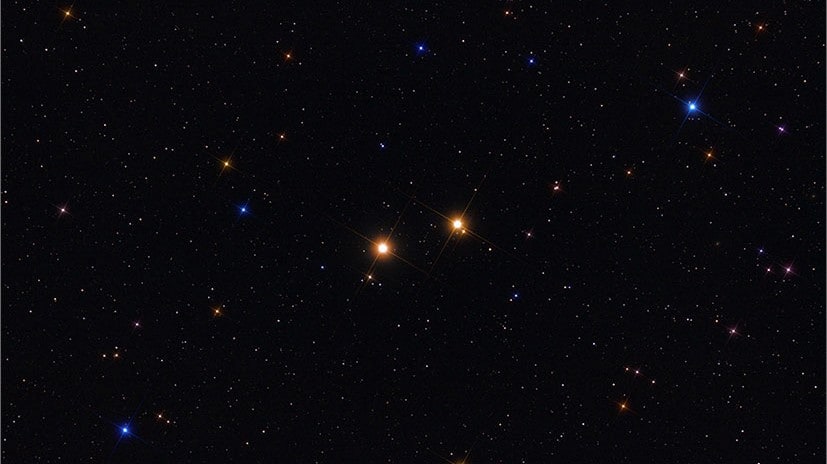
Prima Giedi is a yellow G3 supergiant located at around 870 light-years away from us. Prima Giedi has an apparent magnitude of 4.27, being 1,047 times brighter than our Sun, having 530% of its radius.
Nashira
Nashira, designated as Gamma Capricorni, is a giant chemically peculiar Am star, that has an apparent magnitude of +3.67. It is also classified as an a2 Canum Venaticorum variable star, with its brightness varying by 0.03 magnitudes.
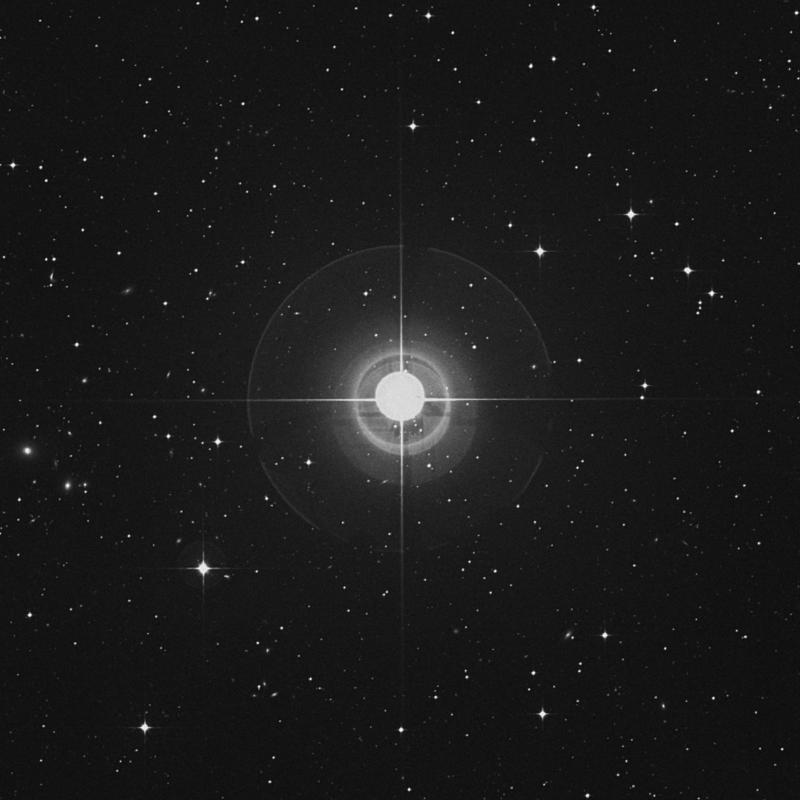
Nashira is located at around 139 light-years away from us, and it is hotter than our Sun, having surface average temperatures of around 7,520 K.
Zeta Capricorni
Zeta Capricorni is a binary star located at around 386 light-years away from us. This star system has an apparent magnitude of 3.74. The primary star is a yellow G-type giant star, also classified as a Barium star since it has overabundances of carbon molecules and s-process elements.
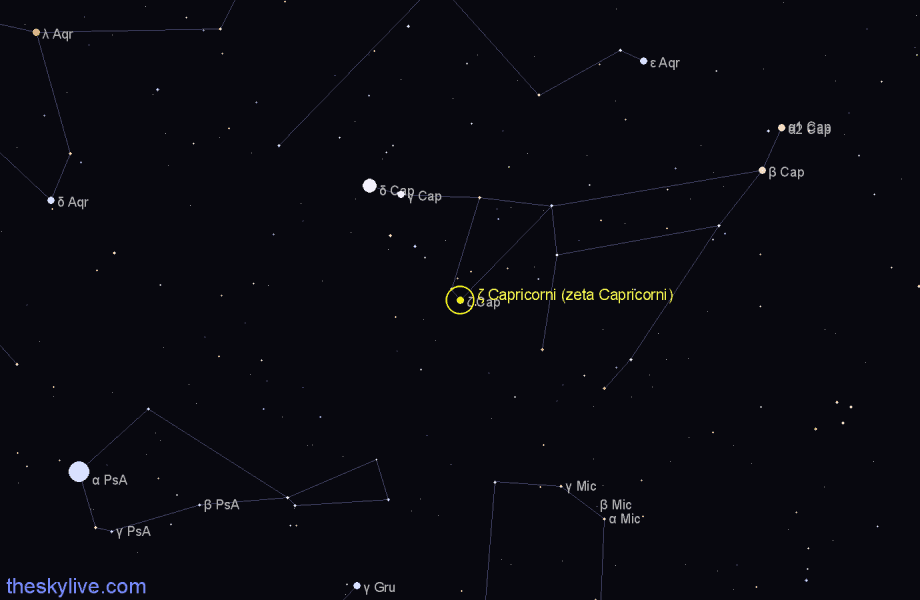
The secondary star is a hydrogen-rich white dwarf. The primary star has around 399% of our Sun’s mass, 2,900% of its radius, and it is 490 times brighter.
The secondary star is considerably smaller, having the same mass as our Sun, yet it is more than three times as hot, with surface temperatures estimated at 23,000 K.
Dorsum
Dorsum, designated as Theta Capricorni, is an A-type main-sequence star with an apparent magnitude of +4.07, situated at around 162 light-years away from us.
Dorsum has around 224% of our Sun’s mass, 270% of its radius, and it is 65 times brighter. This star is almost twice as hot as our Sun, having temperatures of around 10,001 K. It is also a fast-spinning star, with a rotational velocity of around 104 km / 64.6 mi per second.
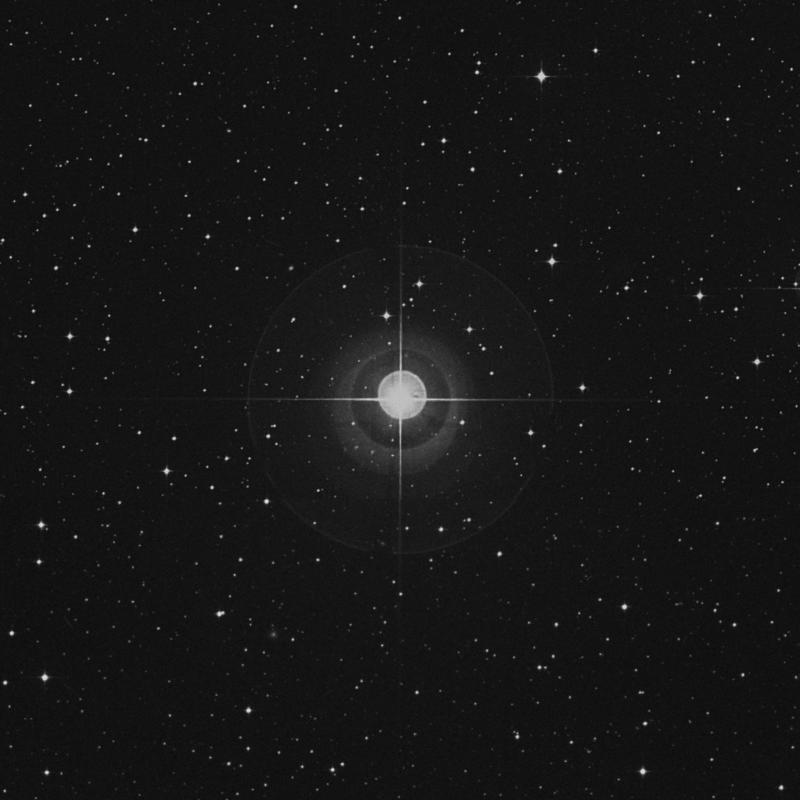
Baten Algiedi
Baten Algiedi, designated as Omega Capricorni, is an M-type red giant star located at around 1,000 light-years away. It has an apparent magnitude of +4.11.
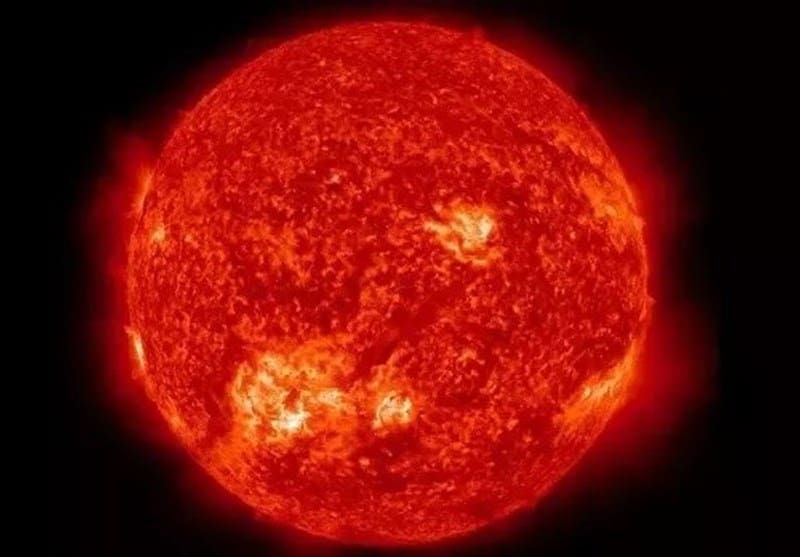
Baten Algiedi has around 680% of our Sun’s mass, 17,210% of its radius, and it is 6,269 times brighter. It is however cooler than our Sun, with temperatures recorded at around 3,915 K.
Psi Capricorni
Psi Capricorni is a yellow-white hued F-type main-sequence star that is located at around 47.9 light-years away from us. It is visible to the naked eye, having an apparent magnitude of 4.13.
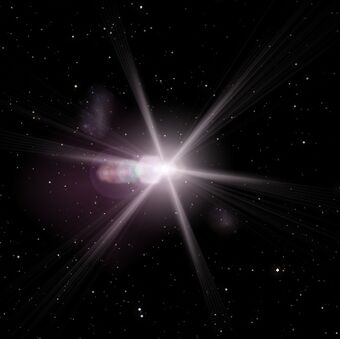
Psi Capricorni has around 137% of our Sun’s mass, 151% of its radius, and it is 3.82 times brighter. This star is hotter than our Sun, having temperatures of around 6,572 K.
Pi Capricorni
Pi Capricorni, also known as Okul or Oculus, is a triple star system located at around 660 light-years away from us. The primary star is a blue-white B-type giant star, having an apparent magnitude of +5.096.
Pi Capricorni has around 590% of our Sun’s mass, and it is 238 times brighter than our Sun. It is also almost twice as hot as the Sun, having temperatures of around 9,623 K.
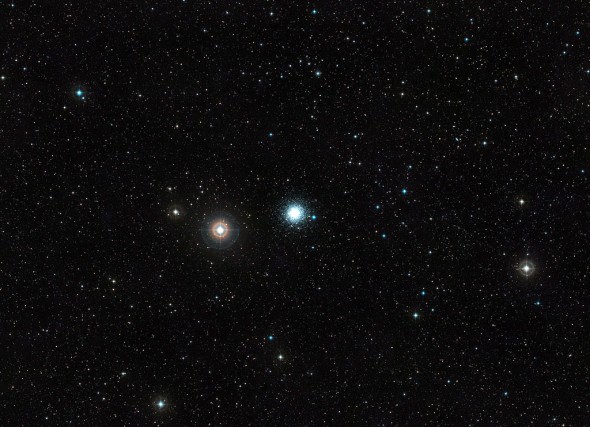
Deep-sky Objects
There are many interesting deep-sky objects present in Capricornus, apart from the aforementioned Messier 30, there are also many more star clusters and galaxies. Some of them are the spiral galaxy NGC 6907, or the large galaxy group HCG 87.
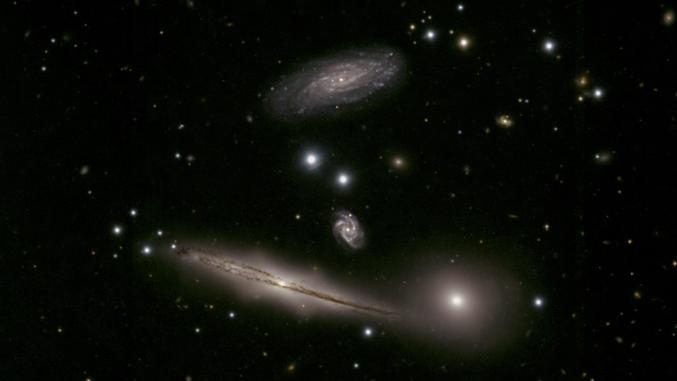
NGC 6907
NGC 6907 is a spiral galaxy located at around 118 million light-years away from Earth. This galaxy spreads for around 115,000 light-years across.
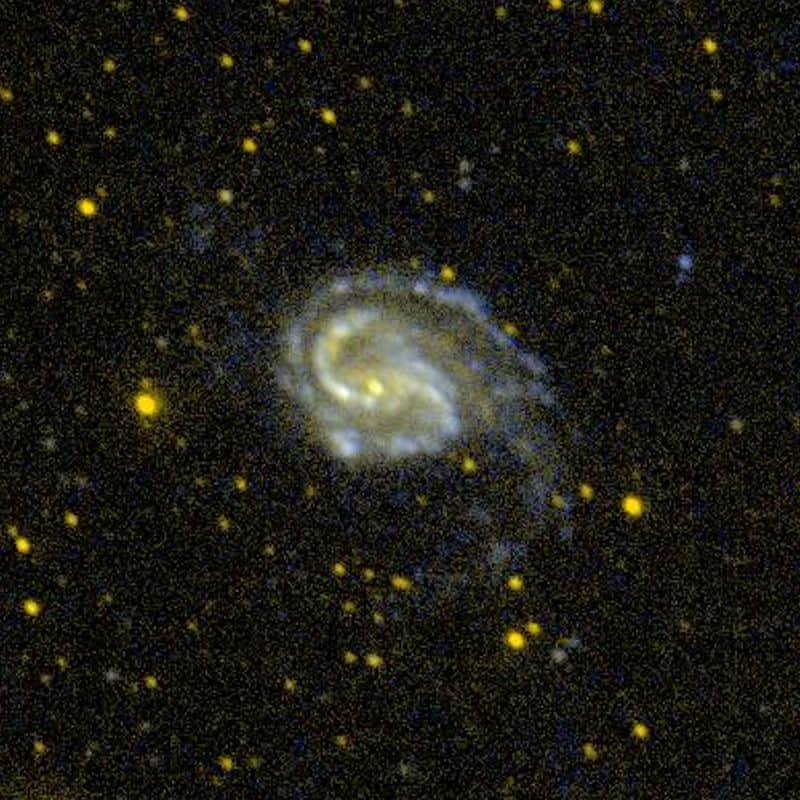
NGC 6907 was first discovered by William Herschel in 1784. This galaxy has an apparent magnitude of 11.1. The galaxy has two spiral arms and an inner bulge.
HCG 87
HCG 87 is a compact group of galaxies located at around 400 million light-years away from the Solar System. This group stands out as one of the most compact group of galaxies, hosting two active galactic nuclei, and a starburst among its four members, all of which show signs of interaction.
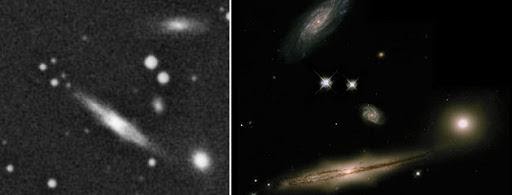
It is speculated that five galaxies are associated with this group, however, only four are currently officially listed, they are:
- HCG 87a – apparent magnitude 15.3
- HCG 87b – apparent magnitude 15.4
- HCG 87c – apparent magnitude 16.1
- HCG 87d – apparent magnitude 17.8
IC 1337
IC 1337 is an intermediate spiral galaxy located at around 420 million light-years away from us. It was discovered in 1892 by Stephane Javelle.
IC 1337 has an apparent magnitude of 14.5, and it has an apparent size of 1.2’ x 1.1’.
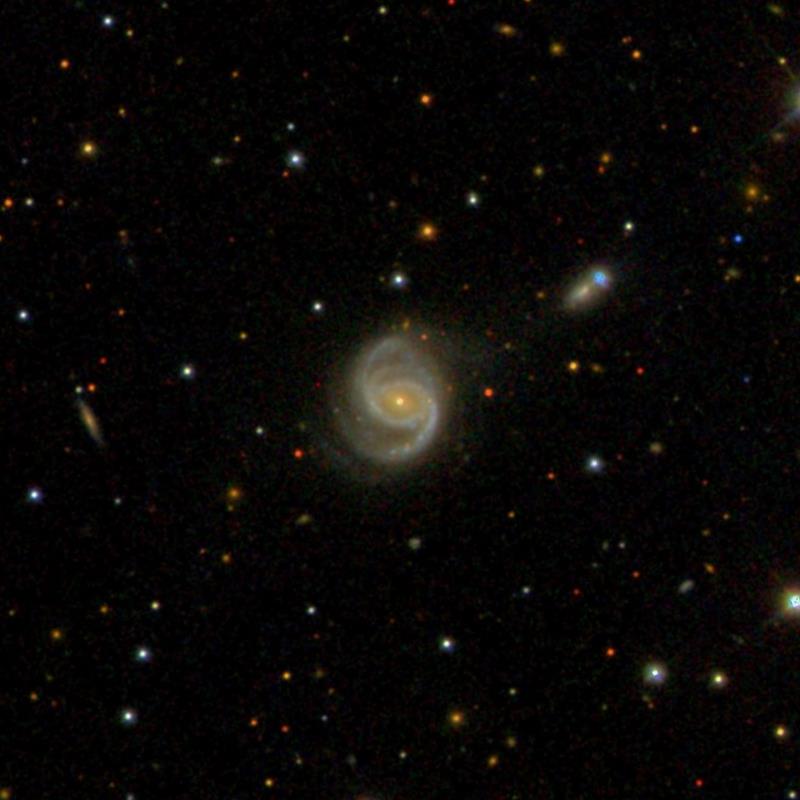
Mythology
The constellation of Capricornus is associated with many myths and images that go way back to the 21st century BC. The ancient Greeks associated Capricornus with the forest deity Pan.
Pan had the legs and horns of a goat, and he was placed in the sky by Zeus since he came to rescue the other gods many times, for example, during the war with the Titans, Pan helped to scare them away by blowing his conch shell and he later warned the gods that Typhon, a monster sent by the Titan Gaia to destroy them, was approaching. He also gave the idea to the gods to disguise themselves as animals until the danger passed.
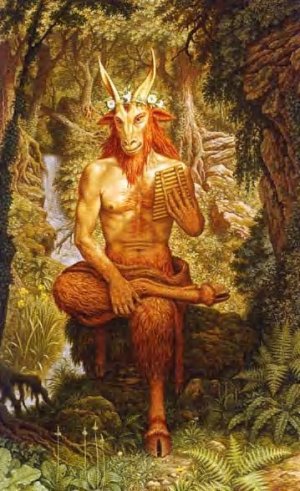
Pan eluded Typhon by jumping into the river Nile and turned the monster’s lower body into a fish, thus granting the chance for Zeus to kill it with thunderbolts. In reference to the myth, Capricornus is commonly depicted as a goat with a fishtail. It is said that Pan had a son, Crotus, who is represented by the neighboring constellation Sagittarius.
Another Greek myth identifies Capricornus as Almathea, the goat that nursed Zeus when he was an infant, hiding from his Titan father, Cronos.
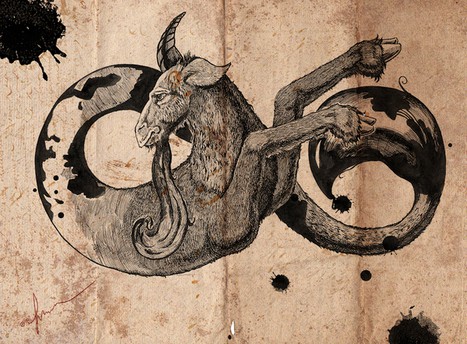
Meteor Showers
There are five meteor showers associated with the constellation of Capricornus, the Alpha, Chi, Sigma, Tau Capricornids, and the Capricornids-Sagittarids.
The most prominent is the Alpha Capricornids. They occur on the 15th of July until the 10th of August. The parent body is the comet 169P/NEAT.
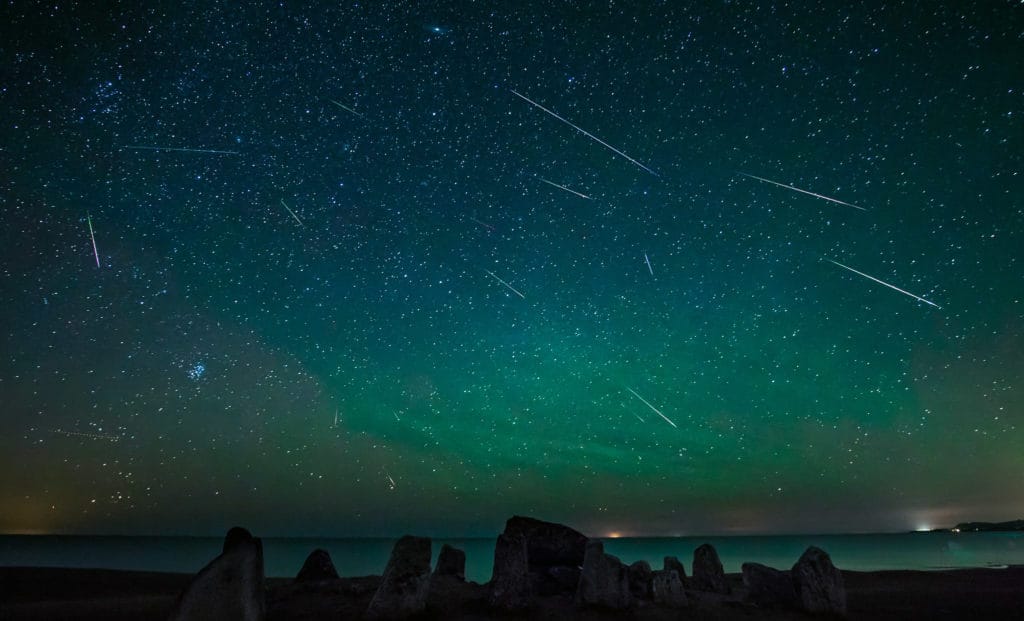
The showers have a peak rate of around 2 to 9 meteors per hour. The meteor shower is speculated to have been created around 3,500 to 5,000 years ago when around half of the comet disintegrated and fell into dust.
The bulk of dust will not be in the Earth’s path until the 24th century, and when this will happen, the Alpha Capricornids will become the strongest annular meteor shower.
Astrology
In the Early Bronze Age, the winter solstice occurred in the constellation, however, due to the precession of the equinoxes, the December solstice now takes place in the constellation Sagittarius.
The Sun is now in the constellation Capricorn (as distinct from the astrological sign) from late January through mid-February. Though the solstice during the northern hemisphere’s winter no longer takes place while the Sun is in Capricornus, as it did until 130 BCE, the astrological sign called Capricorn is still used to denote the position of the solstice.

The latitude of the Sun’s southerly position continues to be called the Tropic of Capricorn, a term which also applies to the line on the Earth at which the Sun is directly overhead at local noon on the day of the December solstice.
Did you know?
- Neptune was discovered in 1846 by Johann Galle while it was near Deneb Algedi.
- The Babylonians associated the goat-fish as a symbol of their god Ea.
- In Chinese astronomy, Capricornus lies in the Black Tortoise of the North.
- The Nakh peoples called Capricornus the Roofing Towers.
- In the Society Islands, the figure of Capricornus was called Rua-o-Mere – Cavern of parental yearnings.
- The constellation of Capricornus is among the oldest in the sky. It was first attested to a cylinder-seal from around the 21st century BCE.
Sources:
Image Sources:
- https://upload.wikimedia.org/wikipedia/commons/thumb/f/fc/Sidney_Hall_-_Urania%27s_Mirror_-_Capricornus.jpg/640px-Sidney_Hall_-_Urania%27s_Mirror_-_Capricornus.jpg
- https://upload.wikimedia.org/wikipedia/commons/thumb/9/95/Capricornus_IAU.svg/633px-Capricornus_IAU.svg.png
- https://www.thoughtco.com/thmb/bBG2DjrgMxOtCvdzJd_RIBAa_-A=/1491×839/smart/filters:no_upscale()/10_NO_HEMI_SUMMER_LOOKINGSOUTH-59e6b15f0d327a0010a03b8e.jpg
- https://maas.museum/app/uploads/sites/6/2012/10/Know-your-constellations_Capricornus.png
- https://www.constellation-guide.com/wp-content/uploads/2011/03/Messier-30-NGC-7099-991×1024.jpg
- https://www.liberaldictionary.com/wp-content/uploads/2019/01/capricornus-4863.jpg
- https://nineplanets.org/wp-content/uploads/2020/02/300px-Deneb_Algedi.jpg
- https://nineplanets.org/wp-content/uploads/2020/02/Algiedi-Alpha-Capricorni.jpg
- https://astrologyking.com/wp-content/uploads/dabih-star-beta-capricorni.jpg
- https://www.constellationsofwords.com/images/stars/dahib.JPG
- https://astrologyking.com/wp-content/uploads/giedi-star-alpha-capricorni.jpg
- https://theskylive.com/sky/stars/star-images/82/8278_800.jpg
- https://theskylive.com/sky/stars/finder-charts/zeta-capricorni-finder-chart.png?c=1586735889
- https://theskylive.com/sky/stars/star-images/80/8075_800.jpg
- https://newsmedia.tasnimnews.com/Tasnim/Uploaded/Image/1396/11/12/1396111218010733913196144.png
- https://vignette.wikia.nocookie.net/thexuniverse/images/8/81/Psi_Capricorni.jpg/revision/latest/scale-to-width-down/340?cb=20120822183749
- https://destepti.ro/wp-content/uploads/2012/06/Roiul-globular-Messier-30.jpg
- https://www.astronomytrek.com/wp-content/uploads/2017/10/HCG-87-677×381.jpg
- https://upload.wikimedia.org/wikipedia/commons/4/45/NGC_6907_GALEX_WikiSky.jpg
- https://lh3.googleusercontent.com/proxy/ePX9kZwBJb2_tkWyqukll1PaYeYPCK3Z15JADHeylTFRvpY5c0ujAhhK8a28gNdvewARg0lvNG_ySBkSbn02kjPsYKrsYaLtmUuExmYfWB5g
- https://upload.wikimedia.org/wikipedia/commons/7/70/IC1337_-_SDSS_DR14.jpg
- https://play-the-game.luisdanielmaldonadofonken.info/wp-content/uploads/2016/06/pan4.jpg
- https://img.scoop.it/wgIIcX9uWiQi49bO6EZ2Kjl72eJkfbmt4t8yenImKBVvK0kTmF0xjctABnaLJIm9
- https://amsmeteors.org/wp-content/uploads/2019/07/featured.jpg
- https://www.nicepng.com/png/detail/433-4330238_capricorn-zodiac-sign-chinese-zodiac-signs-capricorn.png
